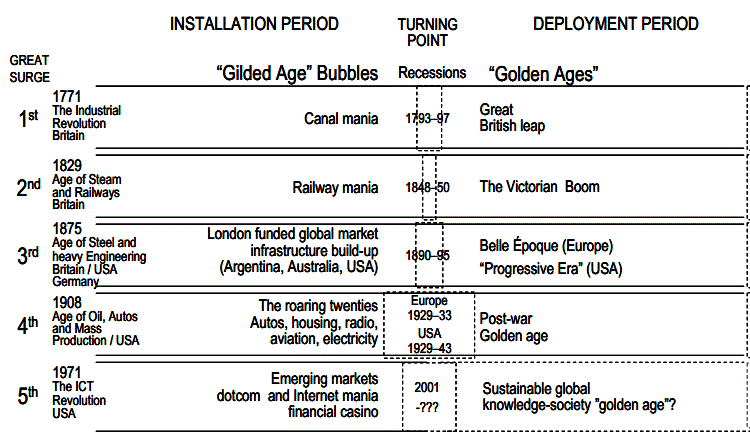I just finished Carlota Perez’s Technological Revolutions and Financial Capital: The Dynamics of Bubbles and Golden Ages. First thought: not for everyone. It’s big picture tech cycle theorizing about economic history.
Yet I found it first rate, and can see why it’s popular with some Silicon Valley investors. In particular Marc Andreessen cites Perez so often, I finally bought the book. It got me thinking. Our current tech cycle is well captured by Andreessen as software is eating the world.
And software is highly prone to monopoly. Reading Perez, I found it hard to avoid the conclusion monopoly is eating the world. Attention must be paid.
Perez is an advocate for what the economist Joseph Schumpeter dubbed Kondratiev waves, long boom and bust cycles driven by successive waves of technological innovation. Perez lists five technology surges:
In chart form below, each wave has an installation period led by finance and free markets. This ends in a frenzied bubble with a financial crisis, creating a turning point that forces institutional reform. Then we get a deployment period where the wave spreads into the wider economy, led by production and the state. The deployment period starts as a golden age, but eventually the technology gets tapped out. Which creates an opening for the next cycle.
- Industrial revolution 1771 to 1829 – textiles, wrought iron, canals, turnpikes
- Steam and railroads 1829 to 1873 – steam engines, iron/coal mining, railroads, telegraph
- Steel and electricity 1875 to 1918 – steal, chemical engineering, electrical equipment and networks, cables, telephone
- Oil, Autos, Mass production 1908 to 1974 – cars, cheap oil and petrochemicals, internal combustion engine, home appliances, refrigeration, roads, universal electricity, radio
- Information and Communication Technologies (ICT) 1971 to ? – microelectronics, computers, software, biotech, global digital telecommunications, internet, high speed physical transport

image source (also see original version from my copy of Perez’s book)
What I find most original (and for some reason neglected in reviews I’ve seen) with Perez’s version of Kondratiev waves is her thesis each wave is associated with a Thomas Kuhn paradigm shift. Note: jargon warning, she uses both paradigm and synergy extensively. For what it’s worth, I think she pulls this off. But mileage may vary. Perhaps the easiest way to illustrate her views on technology paradigms is by tracing historic shifts in the preferred metaphor for mind, as pulled from here. Stoics used fire as a metaphor for mind. By the industrial revolution it was clockwork. Age of steam was hydraulics. Then electricity. Then telegraph. Then electronics. Then computer hardware. And now of course the preferred metaphor for mind is software. What these metaphor shifts show is the technology of each age has such a profound impact on our world view, it alters how we perceive mind itself. Perez is saying the entire package of technology, beliefs, financials, and governance cohere together at the end of installation at the turning point, to form a cohesive whole for deployment. Each age is built upon the last, but incompatible with it. Paradigm shift. Let me pull a Marc Andreessen quote on adapting to our current software age: “People change, then forget that they changed, and act as though they always behaved a certain way and could never change again. Because of this, unexpected changes in human behavior are often dismissed as regressive rather than as potentially intelligent adaptations.”...MUCH MORE